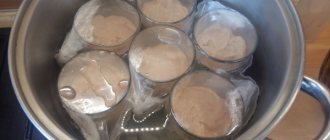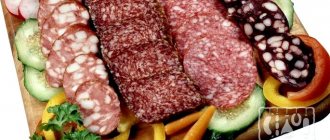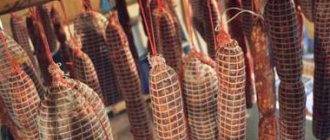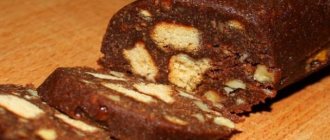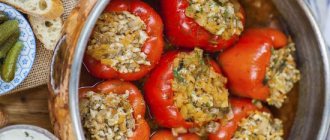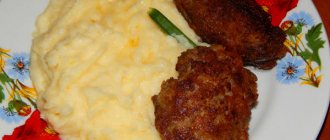a brief description of
Boiled sausage is one of the most popular and beloved foods in the world. There are many varieties of this meat product, each of which has its own unique characteristics. Nevertheless, there are common properties that distinguish all products of this type.
What does it look like?
Boiled sausage has the appearance of an oblong product of elastic consistency, wrapped in a casing. Its texture is uniform and its color is pink. Sometimes a cut of cooked sausage may have inclusions. This is due to the addition of bacon or spices.
Taste and smell
The product has a pleasant meaty, slightly salty taste and has a characteristic smell with a hint of aromatic spices.
Composition according to GOST
GOST clearly regulates the production of boiled sausage:
- The content of pure meat in the product must be at least 30%. In addition to meat, the presence of starch (no more than 8%), as well as salt and substances obtained by grinding animal bones and skin, is allowed.
- The permissible amount of bacon is up to 10% in first-grade sausages and up to 15% in second-grade sausages.
- Eggs - from 3%, milk - up to 5%.
- The color of the minced meat when cut should range from light pink to dark red.
Production technology
The production technology includes the following sequence of main stages:
- Preparation of raw materials. At this stage, the carcasses from which the sausage will be prepared are processed and cut up. Typically, beef, pork, lamb, turkey or chicken are used.
- Deboning and trimming of raw meat.
- Ambassador. © https://ydoo.info/product/varenaya-kolbasa.htmlThe meat is cut into pieces of 0.5-1.0 kg and mixed with salt, the concentration of which should not be higher than 2.5%. The mixture is left for 12-72 hours (depending on the type of sausage) at a temperature of 0...+4 degrees and air humidity of 75%.
- Grinding meat into minced meat, followed by adding spices and other ingredients.
- Filling the shells with minced meat.
- Heat treatment. This stage includes three sequential processes - roasting, cooking and cooling.
Varieties and categories
There are three types of sausages:
- Top grade. In the process of preparing such sausages, high-quality meat, lard, cardamom, nutmeg and other rare spices are used. This variety includes the following sausages: “Stolichnaya”, “Dietetic”, “Doctorskaya”, “Children’s” and others.
- First grade. First grade meat is used, but with the addition of bacon and protein of vegetable origin. These are sausages such as “Calorie”, “Student”, “Pork”, etc.
- Second grade. Trimmed meat and flour are used as the basis for production. The second grade includes “Tea”, “Student”, “Snack” and others.
There are only two categories of cooked sausages:
- Category A. In such a product, the mass fraction of muscle tissue should be more than 60%, not taking into account the water lost during heat treatment. Category A is “Doctoral”, “Amateur”, “Beef”.
- Category B. Muscle tissue content of 40-60% is allowed, excluding water lost as a result of heat treatment. Category B includes “Dairy”, “Calorie”, “Tea”, “Snack”.
Types of boiled sausages
The expansion of production and the popularization of meat products have led to a variety of types of boiled sausages.
- Stuffed sausage is a product in which minced meat and other ingredients are laid out in a casing according to a certain pattern, due to which the cut of the boiled sausage receives a characteristic pattern.
- Sausages and wieners are a type of sausage with a smaller diameter and length. The parts of the product are separated from each other by twisting. These products usually do not contain lard and only use meat from young animals.
- Liver sausage is a type of sausage that contains gray, ointment-like minced meat. This color is obtained due to the absence of sodium nitrate and/or nitrite and subsequent roasting, which are used in the production of other sausages.
- Meat bread is a product consisting of minced meat and without a shell. It has a darker color, low moisture content and virtually no odor.
- Zezel is a sausage product with a high collagen content. The raw materials for the production of this type of sausage are pork head, cheek or tripe.
- Blood sausages are a type of sausage made from offal. The raw materials for production are pig heads, veins, cartilage, cheek, heart and food-grade defibrinated blood. The products have dark red meat and a dark shell.
- Jellies are meat products made from boiled meat or offal and filled with broth.
How to cook?
The technology involves the following stages:
History of origin
The history of sausage originates in Ancient Greece. At first, the sausage did not have a casing: a piece of meat was simply dried and eaten in this form. The idea of creating a casing product belongs to the German Johann Laner, who prepared the first mini-sausages. Such boiled, fried, smoked and stewed products quickly gained popularity in German cuisine.
In the USSR, sausage production began in 1963. It was then that Anastas Mikoyan issued a decree on the production of meat products. One of the first products was “Doctor’s” sausage. It was originally developed for people who suffered during war and post-war times, so its composition was high-calorie and healthy. To prepare one hundred kilograms of product, 25 kg of premium beef, 70 kg of lean pork, 3 kg of eggs and 2 liters of cow's milk were used. No additives, only natural, high-quality products. It was called “Doctor’s” for a reason. This product was manufactured for medicinal purposes, which is why doctors prescribed eating sausage. Long gone are the days when doctors prescribed meat products, but the name stuck with the product.
Another recipe
Homemade boiled-smoked sausages are incredibly tasty, and they also contain a large amount of vitamins. Therefore, we suggest that you familiarize yourself with another recipe. Use:
- 400 grams of premium beef;
- 350 grams of medium fat pork;
- 15 grams of salt;
- 1-3 g pepper (ground black or allspice);
- 1-2 grams of coriander (ground);
- two or three eggs;
- 3 grams of nutmeg and sugar mixture;
- 100 grams of bacon;
- 2-3 grams of garlic (ground);
- intestines (pork or beef, can be replaced with artificial ones, d = 50-65 mm) - to create a shell.
The cooking process takes 120 minutes. Calorie content of 100 grams of product: 257 kcal.
Difference from meat loaf, sausages and smoked sausage
There are many types of sausages that are prepared according to similar recipes, but have fundamental differences in shape, composition and taste. Visual differences are shown in the photo below.
The raw materials for the listed meat products are the same, but there are differences in the cooking technology. Thus, meat bread is most often prepared by baking, and boiled sausage and frankfurters are boiled. As for smoked sausage, it goes through a longer and more complex cooking process, and it also needs some food additives that will prevent the meat from spoiling during the drying and smoking process.
How to choose?
High-quality boiled sausage retains its freshness, taste and aroma longer. When choosing a sausage product, you need to pay attention to the following characteristics:
- Appearance. The casing must be clean, dry, smooth, intact and tightly adjacent to the meat. The presence of mucus or moisture indicates that the product is spoiled.
- The cut of boiled sausage should have a uniform natural color. The inclusion of chemical additives in the minced meat or non-compliance with the proportions of meat are the main reasons why boiled sausage becomes soggy when cut. The presence of spots or other color inclusions indicates a violation of the production technology.
- Consistency. To examine this sign, you need to press or bend a piece of sausage. If beads of fat appear, the product was produced using stale meat. A piece that crumbles between your fingers indicates that a large amount of starch was used in production. If, when compressed, a piece is greatly deformed, it contains less meat than required by the standard.
- Smell. The sausage should have a pleasant meaty smell with a light aroma of spices. Any foreign odors indicate a violation of the production technology and the product is not fresh.
- Compound. When buying sausage, be sure to study the composition. It must comply with GOST.
- Date of manufacture and shelf life. These data are also indicated on the packaging and are important parameters when choosing sausage.
Show everything that is hidden: sausage composition
Boiled sausage must include at least 30% pure meat, the remainder of the volume usually consists of skin, bones, cartilage, fat and connective tissue. It doesn't sound very appetizing, but it's all organic nonetheless. Egg white and starch are used to bind the minced meat; they help make the mass thicker and stabilize its shape. However, many manufacturers manage to save on literally everything and replace the meat component with soy and lard with vegetable fats. This allows you to significantly reduce the cost of the product, but significantly affects the quality and taste of the sausage.
Spices are always used to add piquancy to the product. Most often it is a mixture of allspice, salt and herbs. But some manufacturers go even further and fill the sausage with chemicals. If you pay attention to the label, then familiar inscriptions will definitely catch your eye: E250, E621 and E631 - all these are sodium-based flavor enhancers. Also, many brands of meat products contain artificial colors and preservatives, this makes the product more attractive to the buyer and increases shelf life. Unfortunately, it is quite difficult to find a real organic product, but there is a way out - be sure to read the composition: the shorter it is, the more natural the sausage.
How to do it at home?
Making sausage at home is a good idea for people who have doubts about the composition of a purchased product. And the taste of a store-bought product is not always successful. Even if you know which boiled sausages add your favorite ingredients, such as garlic, coriander or basil, you can’t always find tasty sausage. A homemade product is always richer in meat and has a pronounced taste and smell.
Beef or veal
Beef or veal makes a very tasty sausage. To prepare it, take minced meat, mix it with milk, add spices, a few eggs and grind it in a blender. Then add starch and a tablespoon of alcohol. The resulting mass is mixed, transferred to the casing, and then tightly bandaged. The sausage is cooked for half an hour over medium heat and placed in the refrigerator for 9-10 hours.
Turkey
Homemade turkey sausage has a very pleasant aroma and taste. It is prepared from the thigh of a bird. The meat is ground in a meat grinder and mixed with spices. Separately beat the eggs and milk powder with a mixer. The minced meat is mixed with the resulting substance, wrapped in cling film or casing and placed in the refrigerator for an hour. Then take it out and cook over low heat or steam for 40 minutes.
Chicken
Chicken sausage is made from fillet. It is also ground into minced meat, mixed with milk, eggs, spices and sausages are formed using cling film or casing. Cook them over low heat for about an hour, and then cool and serve.
From pork
The shoulder part, which is free of fatty inclusions, is perfect for making pork sausage. Minced meat is prepared and mixed with other ingredients: egg, milk, salt and spices. The mixture is sent to the refrigerator for 12 hours, and then transferred to the casing. The sausages are cooked for an hour and a half over low heat and then cooled.
From horse meat
This unusual horse meat product is prepared in the same way as other versions of sausages: minced meat is mixed with spices, the intestines are filled with it, and the resulting sausages are placed in boiling water for an hour and a half.
This is interesting! Excess moisture may form during the cooking process. You can remove juice from boiled sausage as follows: pierce the casing in several places, put it on a baking sheet and put it in the oven for 15-20 minutes.
Technology
The cooking process will take about 10 hours. The calorie content of 100 grams of the finished product is 250-270 kcal. They work like this:
1. First, make minced beef.
It is mixed with salt and sugar, placed in a container, then covered with film and infused for 6 hours, using a temperature of 3-4 degrees.
2. Meanwhile, chop the pork and lard very finely and mix it with the minced beef - after it has infused.
3. Next, fill the shell with the prepared mixture and tie the ends tightly. You should definitely use a needle to pierce the intestine in several places.
4. Then the sausages should be placed in a smokehouse for two hours (a temperature of about 90-100 ◦C is used). The main sign of readiness is the color of the product - brown and red.
5. At the end, homemade sausages are scalded for an hour.
Before serving, they should be cooled in water for 10 minutes.
What shells can I use?
Despite the wide variety of casings for making sausage, at home, natural (casings and blues) and artificial collagen are most often used.
Chereva is the name given to small intestines with a diameter of about 20-50 mm. They are good at preparing smoked and boiled sausages, bratwursts and frankfurters.
It is better to give preference to beef casing: it is denser than pork, and therefore easier for preparing sausages at home.
Sinyugi are the cecum of a sheep with a diameter of 40-80 mm. It is convenient for preparing boiled products and ham, as it allows you to make sausage 15-20 cm long at a time.
The collagen casing is made from the split skins of large horned animals, therefore, being, in fact, an artificial product, it is allowed for food. This casing is good for the production of any sausages.
Before using the casings, they must be prepared. Natural ones must be rinsed in cold water for 10 minutes, then soaked for 60 minutes in warm water (temperature 30-35 degrees), and then rinsed again in running water.
The collagen shell is prepared in this way. First, it is soaked for 2-3 minutes in water with a tablespoon of salt. The temperature of the liquid should be 35-40 degrees. Afterwards, the shell is washed in running water and used for its intended purpose.
Homemade chorizo sausage
You will need : 2 kg of lean pork, 2 kg of pork belly, 72 g of nitrite salt, 8 g of paprika, 3 g of ground black pepper, 2 g of white pepper, 30 ml of cognac, sausage casings.
Cooking . Cut the meat into large pieces and freeze a little. Grind lean pork twice in a meat grinder, and grind the brisket only once. Pre-soak the spices in alcohol for 30 minutes.
Mix the minced meat, spices and nitrite salt thoroughly in a deep bowl. Stuff the casing with the mixture, tie it in rings and leave it in the refrigerator for 2-3 days to ferment.
Hang the sausages in a dry place with a temperature of 10-12°C for 2 days, then transfer them to the refrigerator for a day to “rest”. Repeat the “ventilate-rest” cycle twice more.
At the very end, hang the sausage in a dark place with a temperature of 12-18°C for 14-20 days, until it becomes very dense.
When preparing dry-cured sausages, you should be extremely careful! Please note that our recipe uses nitrite salt, not regular salt. This is a mixture of ordinary table salt and sodium nitrite in a proportion of 0.5-0.6%. This proportion is absolutely safe for humans. This salt is used to prevent the development of certain dangerous bacteria.
Suitable spices
The best spices for homemade sausage recipes are:
- Bay leaf;
- pepper mixture;
- paprika.
Garlic, parsley, horseradish and celery perfectly complement the taste. For a more unusual taste, you can add basil or coriander, nutmeg or anise. A good solution would also be to add white mustard and thyme.
Recipe for homemade kupats with potatoes
For the recipe for delicious homemade kupaty with potatoes we will need:
- 1 kg of meat (any kind), chopped lard can be added to dry meat
- 400 g raw potatoes
- Salt
- Spices
Cooking kupaty with potatoes
- It is better to use meat for kupat that is slightly frozen, so it is easier to cut it into beautiful cubes. Finely chop the raw potatoes with a knife. Mix potatoes with meat, salt and spices, stuff sausages. The method for preparing kupats is the same as for homemade chicken sausages.
Storage
As a rule, all information about storage conditions and periods is indicated on the packaging and varies for each type of sausage. But there are also standard provisions.
Conditions
The ideal conditions for storing boiled sausage are a cool place and no direct sunlight. These requirements are met by a refrigerator shelf with a temperature of 0...+6 degrees. Before storing in the refrigerator, the sausage must be placed in parchment paper, a plastic bag or a plastic container.
Important! Storage outside the refrigerator, that is, at room temperature, is unacceptable, since the meat product quickly deteriorates. In this case, its shelf life does not exceed several hours.
Deadlines
Sausage that is stored in the refrigerator at the right temperature will stay fresh for up to two weeks.
Can it be frozen?
It is allowed to freeze boiled sausage. For this purpose, it is first cut into slices, put in a bag and sent to the freezer. Thanks to this storage method, boiled sausage does not spoil for up to six months.
You should know! To properly defrost a product, you need to remove it from the freezer, place it on a plate and place it on the bottom shelf of the refrigerator.
Product storage
- Sausage in an artificial casing can easily lie in the refrigerator for 1.5 months.
- If you took a product in an organic shell, then you should use it within a maximum of 5 days.
- Store strictly in the refrigerator, in a paper bag or parchment. You should not pack sausage in plastic or sealed containers; the product needs at least a little access to oxygen.
- At room temperature, the sausage will begin to deteriorate within 3-4 hours, so be careful when giving it to children at school and keep this in mind when taking it with you on a picnic.
How can you tell if cooked sausage has gone bad?
It is possible to understand that boiled sausage has gone bad by the following signs:
- it becomes covered with unpleasant mucus, becomes slippery and sticky;
- water is released that normally should not be released;
- a white coating or green tint to the meat may appear;
- the product acquires a sour, rotten smell.
Important! Dyes are added to sausage products, so it is not always possible to determine the color of the product. It is better to clarify the permissible storage period and proceed from this information.
What can you make from boiled sausage?
There are many options for what to cook with sausage. In addition to being used as an independent dish, sausage is added to okroshka and other soups, main courses and salads. Porridge with meat sausage is good for dinner. The product can be served as a snack at official celebrations. It harmonizes perfectly with vegetables: corn, peas, beans, tomatoes and cucumbers.
If you are unlucky and get a bad product in the store, you can make puff pastries or pies from tasteless boiled sausage. In baking, meat is well complemented by other flavors.
Since frying boiled sausage in a frying pan is quick and easy, it is considered an excellent snack dish.
The taste of sausage goes well with all kinds of stews and side dishes: with the addition of meat they become richer and juicier. An interesting dish during tea drinking will be sausage fried in batter.
Homemade assorted sausages for frying
You will need : 500 g lean pork, 500 g beef, 500 g chicken fillet, 200 g lard, 2 cloves garlic, 200 ml milk, 2 tbsp. semolina, 1/3 tsp. nutmeg, 30 g salt, 1/2 tsp. marjoram, a mixture of peppers (to taste), peeled intestines (intestines) for homemade sausage.
Cooking . Wash and dry the meat. Grind the pork, beef and lard in a meat grinder, finely chop the chicken fillet.
Add spices, milk and semolina to the minced meat mixture. Knead the minced meat thoroughly and put it in the refrigerator, covered with cling film, for 12-14 hours.
Stuff the intestines with minced meat using a meat grinder, putting a special attachment on it. If you don't have a nozzle, use a homemade funnel made from a cut-off plastic bottle. Tie the sausage into small sausages or rings. Every 5-7 cm, pierce the sausages with a needle so that excess air comes out of them.
These sausages are baked in the oven or fried in a frying pan for 20-30 minutes. Raw sausages can be frozen and stored in the freezer for 1-2 months.
How to cut beautifully?
Beautifully sliced sausage will be an excellent decoration for the holiday table. You can simply cut it into thin pieces and lay it out, alternating with cheese or vegetables, or you can create an unusual composition, for example, roses.
To get an edible flower, the sausage is cut into thin circles, stacked on top of each other in the form of a path, and then rolled into a tight tube. This tube is fixed with an onion feather and the lower part is cut off to give stability. After this, the sausage tube is turned over, placed on a plate and the “petals” are straightened.
An edible hedgehog would be an interesting option for a children's table. To prepare it, the sausage is cut into thin circles, which are folded several times. 5-6 bent circles are connected to each other and secured with a toothpick. The fastened pieces are placed on a plate and decorated with olives or herbs.
Benefits and harms
Store-bought boiled sausage contains many additives, so it may provide only a small amount of benefit. A homemade product, on the contrary, is extremely useful, as it is made from natural ingredients.
Sausage:
- stimulates metabolism;
- improves the functioning of the gastrointestinal tract;
- reduces nervous excitability;
- increases immunity;
- has a slight antioxidant and anti-inflammatory effect.
Boiled sausage can cause harm if harmful ingredients and low-quality products were used in its preparation. Its use is contraindicated for people with allergies to meat or any components of sausage. Chemicals in meat products can cause increased cholesterol and the development of heart, kidney and liver diseases.
Women often wonder whether a nursing mother can eat boiled sausage. Boiled sausage after childbirth and during breastfeeding is allowed in small portions. But during pregnancy it is generally not recommended to use this product. But, if you have a strong desire, you can eat some sausage. Ideally, it should be a natural, home-made product.
People trying to lose weight doubt whether it is possible to eat boiled sausage while losing weight. Additives and preservatives contained in sausage have a negative effect on the human body. And it itself is fatty and high-calorie, so people on a diet should avoid using this product as food.
Boiled sausage for illnesses
Boiled sausage is very tasty, so everyone, young and old, loves it. However, it is worth remembering the peculiarities of its use in certain diseases. In some cases it is allowed in small quantities, while in others it is completely prohibited.
Gastritis
There are no prohibitions on eating sausage in official diets. But nevertheless, it is allowed in small quantities - 50 g per day. During the period of remission, it is best not to eat it in the form of sandwiches, but to add it to cereals or vegetables.
If gastritis worsens, you should avoid eating sausages.
Colitis
During the period of exacerbation of colitis, boiled sausage is strictly prohibited. Despite the desire to try a small piece, you should not do this. Even a small amount of the product affects the course of the disease.
When the pain goes away, dosed addition of sausage to the diet is acceptable.
Pancreatitis
Deciding whether to eat boiled sausage or not should take into account the period of illness. If an exacerbation is currently observed, the meat product should be excluded from the diet. The reason is that the components of sausage contribute to the development of edema and inflammation, and fats are involved in the mechanisms of destruction of pancreatic cells.
As for the remission period, boiled sausage can be added to the diet at this time. But there is a condition: the minced meat in the composition must be completely crushed, and spices and seasonings must be present in minimal quantities.
Gout
Meat products can trigger a gout attack. Therefore, the diet for this disease should be limited to all types of meat products. A few pieces of boiled sausage a week is unlikely to cause much harm, and yet you should not abuse it.
Diabetes
If you have diabetes, you are allowed to eat sausage in small portions. This is because sausage contains a lot of carbohydrates in the form of starch. A few pieces of meat product will not harm a patient with diabetes, and if you want to eat more, it is better to opt for “Diet” sausage. It is prepared from the highest quality meat, and the addition of substitutes or flavorings during the cooking process is completely eliminated.
Cholecystitis
With cholecystitis, diet is of great importance in the treatment process. Eating sausage in large quantities is prohibited. Only occasionally can you eat a few pieces of boiled sausage of the highest quality.
Cirrhosis of the liver
For liver cirrhosis, several types of boiled sausage are allowed. “Doctorskaya”, “Dairy” and “Dietary” are acceptable for use. All of them should be prepared from premium meat with a small amount of spices and the absence of food additives.
How to make boiled sausage. Materials from the webinar “Cooked sausages”
Boiled sausages, also known as emulsified sausages, or how to make Doctor’s sausage correctly
(extended version).
1. First, I would like to talk about the types of emulsified sausages .
In the understanding of our compatriots, boiled sausages mean only boiled sausages, frankfurters, sausages, bacon and meat loaves. That is, finely ground minced meat (emulsion) in a shell of different diameters or without a shell (in the form of meat loaf). This is not entirely true, the concept of “boiled sausages” is not so narrow.
If we take a principled approach to the issue of meat emulsion, then we need to take a broader look at the entire range of sausage products. After all, semi-smoked sausages, salami, servelats, minced dry-cured sausages and pates are also an emulsion of meat protein and fat in various proportions and states.
To understand this issue, I suggest taking a look at the generally accepted classification of minced sausages.
1) Finely emulsified minced meat. These are all types of boiled sausages with homogeneous thin minced meat. For example, sausages such as Doktorskaya, frankfurters, sausages, meat loaves, and also some types of pates.
2) Finely emulsified minced meat with inclusions of large fractions of bacon, meat, offal, vegetables, nuts and plant seeds. For example, Amateur boiled, Mortadella, Veal sausage and other various combinations of this plan.
3) Coarsely ground minced meat - all types of salami with small and large patterns, cervelat (dried and raw smoked, including), sausages such as Krakow, Odessa, Tallinn, etc.
4) Coarsely ground minced meats - all versions of chunk hams (restructured), hams in molds, meatloaves, canned hams. Such meat products can be either boiled or boiled-smoked, dried and raw smoked.
All these groups are united by one technological principle - the need to create an emulsion from meat protein, fat and water. The emulsion is created by grinding meat fibers, releasing salt-soluble and water-soluble proteins from muscle cells and forming strong protein-fat-water bonds.
Grinding can be achieved by cutting with a meat grinder, cutter knives, or by abrading pieces of meat while mixing.
2. Ideal parameters for creating a thin emulsion of cooked sausages with maximum strength properties: protein / fat / water ratio as 4:1:2. Thus, for every part of fat, 4 parts protein and 2 parts water are needed for its complete and strong emulsification. The finer the minced meat is ground, the larger the contact surface of the particles and the more proteins are released into the space between small pieces of minced meat, forming a kind of three-dimensional “sponge” of particles of protein, fat and water. This “sponge” is usually called the “protein matrix” of minced meat.
Almost 100 years ago, from these “ideal parameters” the legendary recipe for “Doctor’s” boiled sausage was created. Of course, the given “ideal” ratios are suitable for modeling in laboratory conditions. We do not have the opportunity to grind the minced meat to the point of complete destruction of all cells; some of them remain intact in the finished sausage mince in the form of a filler, and not an emulsion.
In reality, lean meat cannot be equated to pure protein, just as fatty raw materials cannot be considered pure fat. Therefore, usually there is more than 1 part of fatty raw materials in generally accepted recipes for boiled sausages, because the fat is “packed” in fat cells and during the grinding process this “packaging” of many of these cells remains intact, not destroyed during grinding. This means that such fat cells will be able to participate in binding only with their side walls and they will not be enough to form a meat emulsion in its “ideal proportion,” as described above.
Phosphates, citrates and salt are substances that help break down the walls of meat cells and beat the minced meat into a fine suspension.
Thus, in reality, with allowances for “undergrinding,” the protein/fat/water ratio as 3:1:1 (without phosphate formulations) or 3:1:2 (with phosphates) can be considered ideal for home reproduction.
For these reasons, you should select raw materials for making sausages at home. For example, 50% low-fat raw materials and 50% semi-fat raw materials add up to approximately the same ratios. Bold raw materials are conventionally half fat (pork belly with layers of fat, for example). In total, we get 3 parts of low-fat raw materials (2 parts from low-fat raw materials and 1 part from semi-fat raw materials) to 1 fatty part (from semi-fat raw materials), all this is conditional, of course.
Simply put, from practice, a 50:50 ratio of low-fat and half-fat raw materials allows you to create a stable minced meat emulsion at home for any boiled sausages, frankfurters, and small sausages. Meat can be from any animal.
The main condition for creating a strong sausage emulsion is maintaining a temperature during grinding that does not exceed 10...12 degrees Celsius . When these temperatures are exceeded during mechanical action (meat grinder, blender, cutter), fat cells are destroyed and fat droplets are released into the structure of the minced meat. There is too much fat, the minced meat turns white and looks like mayonnaise. There is not enough protein capable of contacting this fat released from the cells. Subsequently, this process leads to fatty swelling under the shell during heat treatment. The structure of the sausage will be loose and similar to pate. This process is irreversible; whitened minced meat cannot be corrected by anything, so monitor the temperature of the minced meat when grinding. If necessary, stop and freeze.
3. The process of emulsification of finely ground minced meat is traditionally divided into several stages:
It is ideal if the ground minced meat has previously been frozen (up to 0...-4 degrees inside). Such minced meat does not have to be cooled during the grinding process using cold water, ice or freezing, interrupting the process. In this case, ice water or ice is introduced in two parts. First, the first half when chopping lean raw materials (for example, beef), the second half when adding fatty raw materials to the chopped lean meat.
If the raw material was not frozen, then moisture is added in the form of ice water or fine ice (preferably). Add fractionally, in parts throughout the entire grinding process, constantly monitoring the temperature of the minced meat. I repeat, it should not rise above 10...12 degrees. Celsius. When gradually added in small portions, the entire volume of this moisture is completely absorbed into the minced meat, and it remains thick.
1) First of all, in a cutter (blender), low-fat raw materials are first ground without water. At this stage, add all the salt from the recipe. Thick minced meat and a high concentration of salt at the initial stage of fine grinding of minced meat help to quickly destroy muscle fibers and dissolve the entire available volume of salt-soluble proteins.
At the same stage, to accelerate emulsification and disclosure of meat protein, phosphates, citrates in pure form or their mixtures with spices are added.
After 2-3 minutes of grinding, a large amount of meat extract containing meat protein is released into the minced meat. You can introduce fatty raw materials.
2) Frozen fatty raw materials and bulk ingredients (spices, milk powder, egg powder, starch) are added at a temperature not exceeding 5...6 degrees Celsius. Fatty raw materials are easily destroyed, forming a strong emulsion. Bulk ingredients - milk powder, starch, egg powder, flour bind the moisture that was not used to create the emulsion. But we should not forget that high-quality fine grinding of raw meat does not require the addition of dry ingredients!
3) When reaching 10...12 degrees. Celsius fine final grinding of minced meat must be stopped. At this stage, bacon is usually added, which is chopped into pieces, as well as structural inclusions (large pieces of meat, spices, nuts).
The minced meat is ready for stuffing and subsequent heat treatment.
4. Mistakes leading to defects made during grinding.
Why is it so necessary to observe the temperature regime when grinding? The fact is that when grinding in a cutter, blender, and especially in a meat grinder (with dull knives or large gaps between the knife and the grate), local overheating of the minced meat is possible, leading to heating of the fat and local denaturation of the protein, its boiling, and, as a consequence, to the destruction of the emulsion in the protein matrix.
Unbound fat is the main cause of sausage failure. It is the cause of broth-fat edema - this is when we receive separate dry minced meat and broth under the casing instead of homogeneous, dense and juicy sausage.
5. Ways to prevent fat and broth swelling when grinding minced meat.
In fact, all methods of preventing defects come down to banal adherence to the principles of forming thin emulsions. We will list them:
1) It is necessary to create conditions for maximum release of meat protein from muscle cells into the minced meat. The grinding sequence is critical in this matter. To do this, first grind low-fat raw materials with salt, phosphate and citrate mixtures with fractional addition of water, and then add fatty raw materials.
2) Compliance with grinding temperature. Muscle fibers are easily destroyed and release protein at a temperature of about zero degrees, so it is better to slightly freeze the raw materials before grinding. The same measure will give us additional time during grinding for maximum extraction of soluble proteins into minced meat.
3) You should carefully monitor the sharpness of the cutting edges and the absence of gaps in the cutting parts of the mechanisms of the meat grinder, blender or cutter. Dull knives heat up the minced meat very much and quickly lead to its overheating, followed by the formation of broth edema.
6. Functional additives.
To further facilitate and release meat protein from muscle fibers, sodium phosphates and sodium citrates .
Phosphates (salts of phosphoric acid) in minced meat break the bonds between actin and myosin molecules and create the maximum number of free protein bonds to create emulsions of water and fat. That is why they are most often used in the industrial production of meat products.
Phosphates make it possible to obtain the most juicy, tender product that will be easily digestible by humans. The addition of phosphates allows you to bind and saturate the minced meat with moisture. Up to 20...25% additional moisture in minced boiled sausage will give it juiciness and contribute to the proper formation of minced emulsion. Adding more moisture will result in a loose consistency in the mince, while using phosphates without adding water will result in a dry, dense texture in the sausages.
Citrates (citric acid salts) only promote swelling of muscle fibers and facilitate their mechanical destruction. Additionally, citrates help preserve the bright red pigment of meat, formed by the interaction of sodium nitrite (from nitrite salt) and meat myoglobin. It is the ability to preserve sodium nitrite from destruction during the color formation of minced meat that makes it possible to reduce the required amount in recipes by 2 times. Thus, nitrite salt in the presence of citrates can be used in a mixture with table salt in a percentage ratio of 25:75. While in citrate-free sausage recipes it is allowed to replace nitrite salt with table salt by only 50%.
Products with citrates are not as juicy as those with phosphates. But the big advantage of citrates is that they are safe for the human body and therefore are approved for use in children's sausages and sausages.
The addition of citrates allows you to bind only 10...15% of additional moisture, in contrast to phosphates, which, as mentioned above, can bind another 20...25% of water to the minced meat, but the very presence of citrates in the minced meat gives it a fuller taste and a bright red color .
We should not forget about the possible harm from overdoses of phosphates in the diet of a modern person. Indeed, along with sausages, phosphates are used in processed cheeses, as fertilizers for plants, as water softeners in household filters and in water supply systems, also in vegetables, etc.
Optimal dosages for home use: pure phosphates - 2...4 g/kg of minced meat, citrates - 4...6 g/kg. Do not exceed these limits.
The combined use of phosphate and citrate functional mixtures is not permissible!
7. Stuffing and forming sausages.
The high viscosity of thin emulsions usually results in an abundance of small air bubbles, creating pores in the finished product. If possible, pores should be removed by kneading or beating.
When stuffing the casing using meat grinders or screw syringes, special attention should be paid to possible overheating of the minced meat on the screw due to friction. This can lead to broth swelling in the finished form. This is described in detail above.
8. Settling and ripening of finely ground sausages.
Finely ground minced meat does not require long salting and ripening. Salting occurs simultaneously with grinding, and the fine fraction of minced meat is salted 10-30 minutes after grinding. Therefore, minced boiled sausages, frankfurters, and wieners are traditionally made from unsalted frozen raw materials.
Before heat treatment, thinly emulsified minced meat is usually kept warm for 20-40 minutes (+18...25 degrees Celsius) for uniform heating. This allows you to get a brighter and more stable pink color of the sausages and reduces the formation of small pores on the cut of the finished sausages. Holding boiled sausages for a longer period of time in a warm place can lead to banal souring of the minced meat and resulting in inedible waste.
9. Heat treatment of boiled sausages .
All sausages are thermally processed at a temperature not exceeding 80 degrees. Celsius until reaching 69...72 degrees. inside the product. The heat treatment time depends on the diameter of the sausage loaf. For example, sausages will be ready in 20...30 minutes when placed in a preheated oven at 80 degrees. temperature is Wednesday, and boiled sausage in an 80 mm casing will be ready in approximately 2.5...3 hours. Focus on the temperature inside the product. When overcooking and the temperature inside the product rises above 72 degrees. there is a high probability of getting defects in the form of edema under the membrane.
The heat source is not important; it can be hot water, steam, oven or smoker. The main parameter is the heating temperature should not exceed 80 degrees. Celsius.
Possible errors during heat treatment:
1. Overheating of sausages above 80 degrees. Celsius always leads to defects in the form of broth edema.
2. Do not heat sausages above 72 degrees Celsius inside. This often leads to a loose minced meat structure and broth swelling.
10. Cooling sausages.
Due to high humidity, boiled sausages do not last long. Therefore, finished sausages should be quickly cooled in order to quickly pass the temperature of 38...25 degrees Celsius inside. After all, heating sausages to 72 degrees. inside does not provide complete sterilization, but only kills living forms of bacteria, but from spores at a favorable temperature of 38...25 degrees. The bacteria are growing rapidly again. That is why boiled sausages are quickly cooled to +2…+4 degrees. Celsius in ice water or in the refrigerator.
Pavel Agapkin
